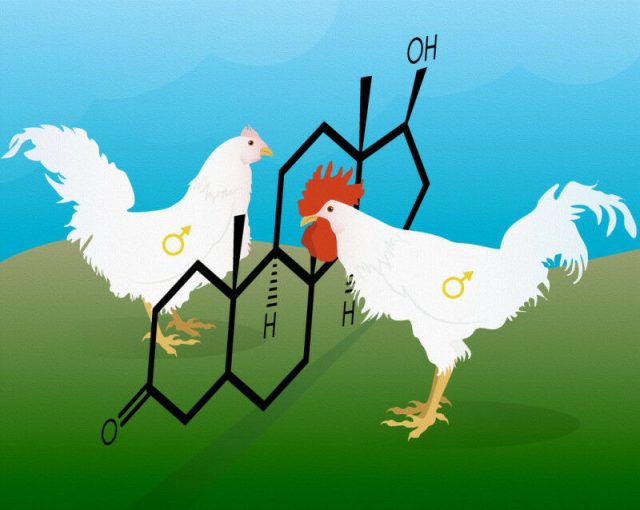One way the -male hormonetestosterone works is by binding to the androgen receptor. Researchers at the Technical University Munich and the Max Planck Institute for Biological Intelligence have succeeded in breeding chickens without the androgen receptor for the first time. This allowed them to study how androgen signaling affects development and appearance: animals of both sexes are infertile. In addition, some – but not all – outer physical traits are underdeveloped. This illustrates the importance of testosterone for both sexes. However, it also shows that the androgen signaling pathway alone does not make a rooster.
Why does the rooster crow and the hen does not? This question prompted the scientist Arnold Adolph Berthold to castrate a rooster in the mid-19th century. The result of his experiment: the rooster’s morning crow was over. At the time, Berthold did not know which substance in the rooster’s testicles might be involved – we now know that it is the sex hormone testosterone.
Although testosterone is also present in females and has important functions there, it is classically referred to as the -male hormone-: it significantly contributes to the sexual development, appearance and aggression behavior of males. To exert its function, testosterone binds to the so-called androgen receptor. This is then activated and triggers the production of certain proteins in the cell. However, testosterone can also be metabolized into estrogen – the -female hormone- – which binds to a different receptor. This is where things get complicated: when we talk about testosterone and its effects, what is the role of the androgen signaling pathway?
Genetically modified chicken
A team of scientists around Benjamin Schusser from the Technical University Munich and Manfred Gahr from the Max Planck Institute for Biological Intelligence has taken a closer look at this question in birds. In a complex undertaking, the researchers used the CRISPR-Cas method to create genetically modified chicken that lack the androgen receptor. This allowed the researchers to study for the first time the effects of androgen signaling on the development, appearance and behavior of chickens. The species was particularly well suited for the study. Chickens are intelligent and social animals that exhibit gender-specific behaviors such as roosters crowing in the morning.
As expected, the examination of the young roosters showed that they were infertile. In addition, some of the typical external sexual characteristics were underdeveloped. These included the comb, wattle and earlaps. Interestingly, other traits remained unaffected by the genetic modification: the tail feathers and the spurs were comparable to normal roosters. -We were surprised to find that the male traits were only partially lost. The outer appearance of roosters is therefore not soley determined by the androgen signaling pathway,- explains Mekhla Rudra, one of the two lead authors of the study.
Egg formation and laying are androgen-dependent
Interestingly, young hens without the androgen receptor showed a very similar picture. They were also infertile and the typical head ornaments were much smaller than normal. As a result, young roosters and hens were almost indistinguishable in appearance – quite unlike chickens that carry the androgen receptor. Surprisingly, although adult females continued to produce testosterone, without the androgen receptors they never lay eggs nor ovulate, showing that egg formation and laying are androgen-dependent.
The results show that testosterone plays an important role in both sexes. It is therefore too simplistic to describe it as a pure male hormone. The way the hormone works is complex and not yet fully understood. Additionally, the study provides general insights into the sexual development of birds, which appears to involve a complex interplay of hormone-dependent and hormone-independent mechanisms.
Kamila Lengyel # , Mekhla Rudra # , Tom V.L. Berghof, Albertine Leitão , Carolina Frankl- Vilches , Falk Dittrich, Denise Duda, Romina Klinger, Sabrina Schleibinger , Hicham Sid, Lisa Trost, Hanna Vikkula , Benjamin Schusser*, Manfred Gahr *
#
* these authors jointly supervised this work




